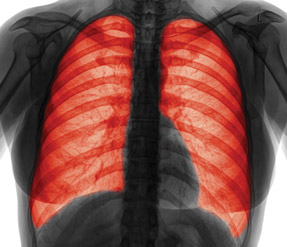Corticosteroids have fallen out of favor for COPD care
A single study has gone a long way toward changing clinical practices.
Envision yourselves one year ago, Jean Bourbeau, MD, instructed attendees at CHEST 2016, before asking which medications they would prescribe to a patient with chronic obstructive pulmonary disease (COPD).

His goal was to highlight how dramatically a single study, the FLAME trial, had changed practice between its publication in the New England Journal of Medicine on June 9, 2016, and the gathering of pulmonary specialists in October 2016 in Los Angeles.
With two shows of hands, reflecting their past and current prescribing, the audience confirmed that the combination of inhaled corticosteroids (ICS) and long-acting beta-agonists (LABA) for COPD has fallen significantly out of favor. “Wow. Have we been wrong that long?” asked Dr. Bourbeau, a respirologist and professor of medicine and epidemiology and biostatistics at McGill University in Montreal, Canada.
He, and most of the other COPD experts speaking at the meeting, reviewed the findings of the trial, which randomized 1,680 patients with an exacerbation in the previous year to a year of treatment with either indacaterol, a LABA, plus glycopyrronium, a long-acting muscarinic antagonist (LAMA), or salmeterol, a LABA, plus fluticasone, an ICS.
The rate of exacerbations was found to be 11% lower in the LABA/LAMA group. “It appears that ICS is not a necessary part of combination therapy in terms of reducing exacerbations,” said Donald P. Tashkin, MD, a professor of medicine at the University of California, Los Angeles (UCLA).
Dr. Bourbeau had reservations. “I can't believe that we've been wrong all these years. I like to believe there are some patients where we did the right thing,” he said, noting that the industry-funded trial was primarily structured to show noninferiority.
One potential limitation of the study is its small portion of patients with frequent exacerbations. Only 20% of trial patients had two or more exacerbations in the previous year. “If you have a patient who has 20 exacerbations a year—maybe I exaggerate a little—but before you generalize the results of FLAME, maybe you have to confirm the validity of a study to the entire population of COPD or you limit the results to the population that was studied,” said Dr. Bourbeau.
It's becoming increasingly clear that the COPD population is not a homogenous entity, various experts explained. “We all consider the patients essentially the same. We know there is quite a bit of heterogeneity in COPD,” Dr. Bourbeau said. “We're probably going to start hopefully to identify some groups and approach them for a different management point of view.”
Eosinophils in the blood have lately shown potential to identify patients who might be more likely to benefit from ICS therapy. For example, a post hoc analysis of two trials, published in June 2015 in The Lancet Respiratory Diseases, found greater benefit from ICS treatment (specifically, reduced exacerbations) in patients with eosinophil counts of 2% or higher.
The problem is “two-thirds or more patients will have 2% or more,” said Dr. Bourbeau. He proposed using higher cutoffs for high eosinophils, although he noted more research will be needed to determine the appropriate threshold for choosing a therapy. “There is no magic number. Two percent seems to be low; 3.5% or 4% or an absolute value of more than 300 [eosinophils/mm3] may work,” he said, noting that these cutoffs need to be tested.
Some experts see additional problems beyond choosing a cutoff. “I'm still not convinced with eosinophils,” said Sanjay Sethi, MD, a professor of pulmonary, critical care, and sleep medicine at the State University of New York at Buffalo. He noted that his own recent research has found significant variation in eosinophils, even in the same patient over time.
“Bronchiectasis may be a biomarker, but again we need more data,” Dr. Sethi suggested. Dr. Bourbeau agreed. According to one study, as many as half of COPD cases are due to abnormal lung growth and development, with these patients having only normal declines in forced expiratory volume (or FEV1), he reported.
The experts expressed optimism that the significance of these and other biomarkers in COPD will be pinned down relatively soon, allowing physicians to test for them and individualize treatment based on the results. “Hopefully, we're going to come to the point where we have a clinical decision algorithm,” Dr. Bourbeau said.
Research and changes are also underway for the subgroup of COPD patients who also have features of asthma. That's currently known as asthma-COPD overlap syndrome, or ACOS, but the “s” is going away, Dr. Bourbeau predicted. “We don't have any data now to be able to talk about a syndrome,” he said. Those are patients who are likely to benefit from ICS therapy, noted Dr. Sethi.
For patients without such special considerations, the consensus was that treatment starts with a LAMA (which is also recommended by the American College of Chest Physicians and Canadian Thoracic Society guideline), then add a LABA. The next step is a little more uncertain, according to the experts. “Studies are underway comparing the effect of LABA/LAMA versus LABA/LAMA/ICS for exacerbation prevention,” said Dr. Bourbeau.
And don't forget the nonpharmaceutical therapies you can prescribe, the experts reminded attendees. “We've got three major things we can offer to a patient with COPD. We have bronchodilators; we have oxygen therapy; we have pulmonary rehab,” said Richard Casaburi, PhD, MD, a professor of medicine at UCLA and medical director of the rehabilitation clinical trials center for LA BioMed, a research institute in Los Angeles.
Pulmonary rehab is provided much more rarely than the other two, he and other experts noted. Despite guidelines and statements supporting the use of rehab, 2.6% of COPD patients received it in 2003, a rate that increased only to 3.7% in 2012. “Probably by the turn of the next century, we'll get up to 50%,” joked Brian Carlin, MD, a pulmonary rehabilitation physician in Pittsburgh.
That's a long wait, but in the meantime, those interested in COPD have new guidelines and recommendations to work with. “GOLD [the Global Initiative for Chronic Obstructive Lung Disease] is revamping completely from 2011. This is going to be much more in line with new studies, a bit more guided on the type of patient,” said Dr. Bourbeau.





